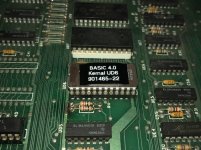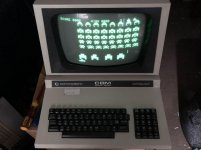Witchy
Experienced Member
Hi folks,
Long time no post, life and non-PET projects got in the way. I'm slimming down my PET collection because nobody needs 12 and I'm moving house, and was just going to list them on e*ay as faulty/untested.
Then I realised my repairing conscience wouldn't let me do that* and have already fixed up an 8096 (dead Editor ROM) and discovered to my surprise a spare 3032 worked fine without me doing anything to it. The next one is a 4032 with 40 col 8032080 board, and after replacing the white CPU socket I fitted my Tynemouth Software ROM/RAM board and slowly eliminated faulty items until it's now just providing the lower 16K RAM to boot, so I have a RAM fault.
Half of the RAM chips are socketed already so I've tested those in my 4116 RAM tester and also cleaned up and refitted R10 and R11 which had been badly butchered by whoever worked on this last. Both CAS0 and CAS1 measure 27ohms back to those resistors from each chip so they're still good despite how they look. The power is OK at 12.05V, -5.06V and 4.88V and there's continuity along both banks though I've just realised I haven't tested back to and beyond UE8/9/10 for the address bus. There's a task for tomorrow.
I've watched CAS/RAS/WE/DI/DO with a logic analyser and they all seem stable with no dead spots.
I feel lazy asking for help at this point but I bow to the superior board experience of people here. I put DaveR's excellent PETTEST V4 onto a 2516 and it's showing 'b' for 99% of the memory locations but crucially not all of them. Just for the hells of it I enabled the lower 16K of the ROM/RAM board just to watch PETTEST complete :D
Any tips for where to look next before I start checking the LS244s for dead gates?
Cheers!
Witchy
*apart from an 8032 that's missing half a dozen chips and has a few lifted traces plus cracked CRT neck, hate to think what the previous owner did to THAT one
Long time no post, life and non-PET projects got in the way. I'm slimming down my PET collection because nobody needs 12 and I'm moving house, and was just going to list them on e*ay as faulty/untested.
Then I realised my repairing conscience wouldn't let me do that* and have already fixed up an 8096 (dead Editor ROM) and discovered to my surprise a spare 3032 worked fine without me doing anything to it. The next one is a 4032 with 40 col 8032080 board, and after replacing the white CPU socket I fitted my Tynemouth Software ROM/RAM board and slowly eliminated faulty items until it's now just providing the lower 16K RAM to boot, so I have a RAM fault.
Half of the RAM chips are socketed already so I've tested those in my 4116 RAM tester and also cleaned up and refitted R10 and R11 which had been badly butchered by whoever worked on this last. Both CAS0 and CAS1 measure 27ohms back to those resistors from each chip so they're still good despite how they look. The power is OK at 12.05V, -5.06V and 4.88V and there's continuity along both banks though I've just realised I haven't tested back to and beyond UE8/9/10 for the address bus. There's a task for tomorrow.
I've watched CAS/RAS/WE/DI/DO with a logic analyser and they all seem stable with no dead spots.
I feel lazy asking for help at this point but I bow to the superior board experience of people here. I put DaveR's excellent PETTEST V4 onto a 2516 and it's showing 'b' for 99% of the memory locations but crucially not all of them. Just for the hells of it I enabled the lower 16K of the ROM/RAM board just to watch PETTEST complete :D
Any tips for where to look next before I start checking the LS244s for dead gates?
Cheers!
Witchy
*apart from an 8032 that's missing half a dozen chips and has a few lifted traces plus cracked CRT neck, hate to think what the previous owner did to THAT one






